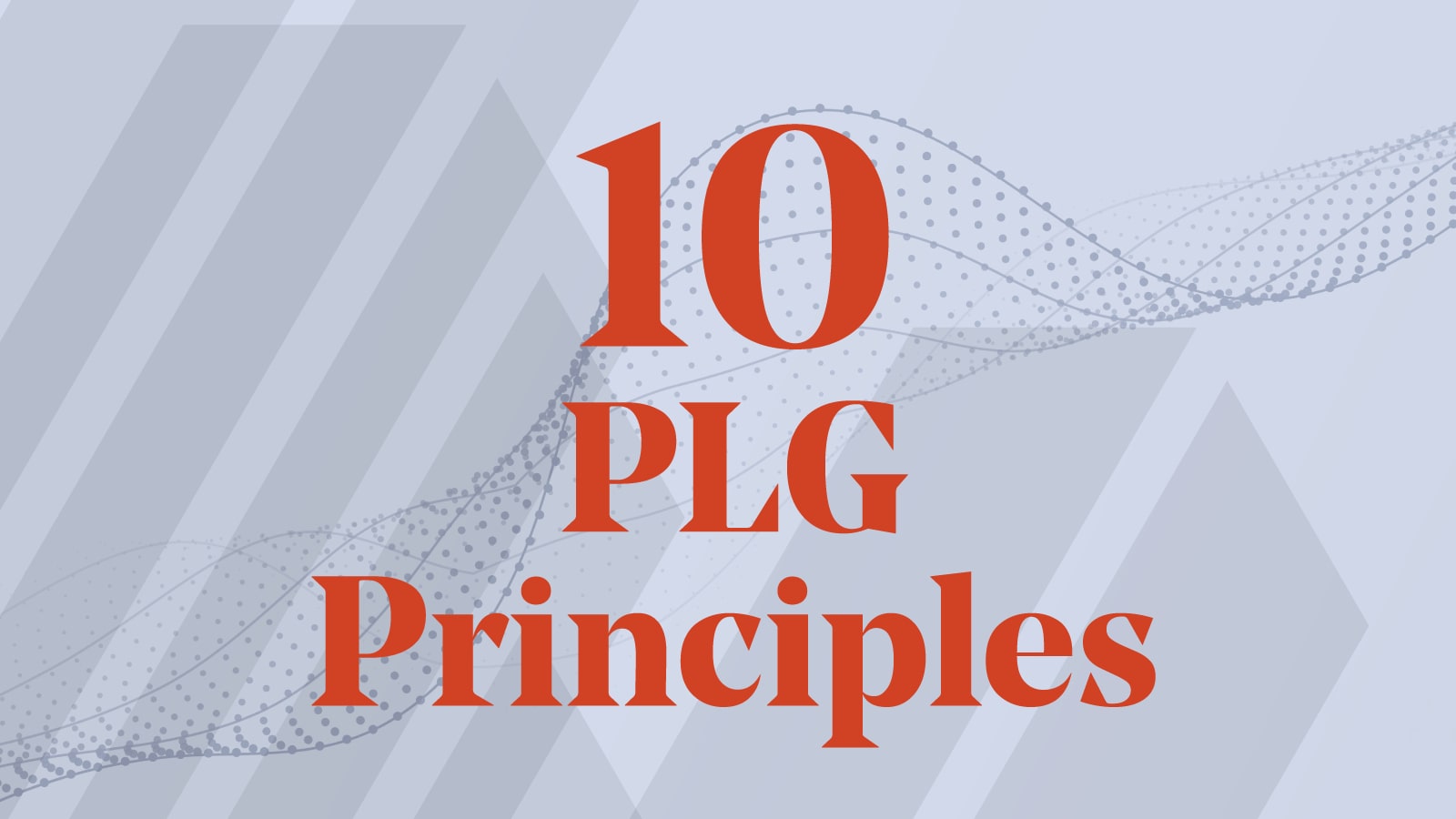Seven product strategies to prevent churn for B2B AI app leaders
Preemptive ways AI app builders can safeguard their business from the pernicious leaky bucket syndrome.
The release of ChatGPT in late 2022 unleashed the floodgates on mainstream AI adoption by putting the power of large language models directly in the hands of everyday consumers. Over 100 million people had experienced AI within mere months of the launch, and businesses soon followed suit. The tech industry saw a surge of AI-native and AI-embedded consumer applications, prompting OpenAI to launch the GPT store earlier this year. Many consumers around the world have now tried ChatGPT or other B2C AI apps — but did these users stick around?
With over a year of data on consumer behavior related to B2C AI apps, an early trend has emerged — while consumer AI apps have experienced strong top-of-funnel growth and accelerated user acquisition, these businesses have also experienced a notable “leaky bucket” problem. User retention and engagement metrics of consumer AI apps are markedly weaker than incumbent consumer apps:
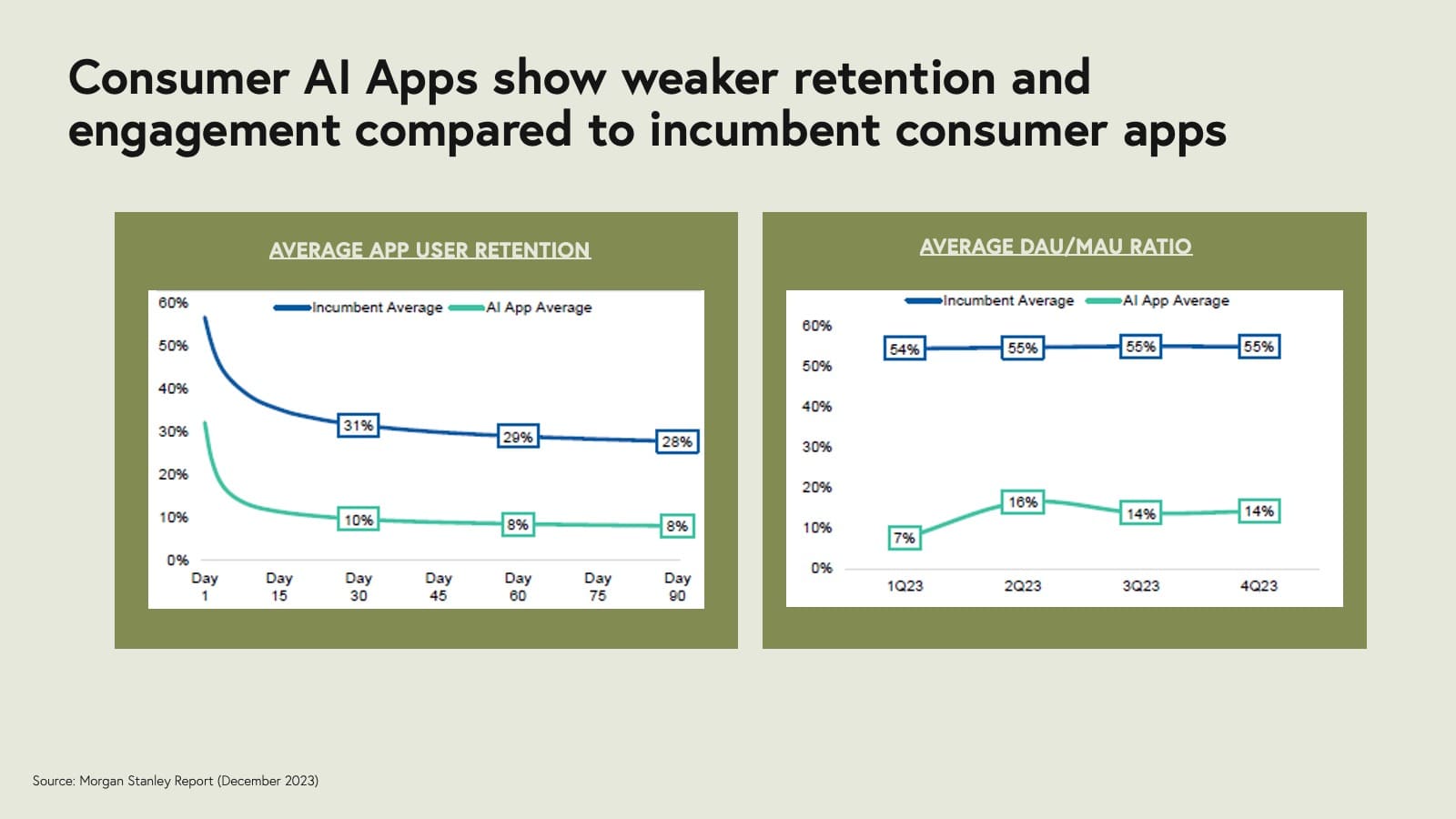
In other words, churn is one of the most prevalent issues plaguing consumer AI businesses as they struggle to retain long-term customers and drive habitual usage. There are several plausible reasons for this phenomenon, including a growing competitive landscape as the democratization of AI model APIs have lowered barriers to entry for B2C AI startups.
While every new market opportunity comes with initial growing pains and adjustment periods, churn is not a concern to be taken lightly. Eventually AI novelty will wane and the growth momentum of these types of businesses will slow down. It will be significantly harder to maintain growth if B2C AI companies are struggling to plug a sizable churn gap every month.
As enterprise investors, we often observe how B2C trends could map to B2B businesses. So a key question emerges: Will B2B AI Apps suffer from the same churn fate seen in B2C AI Apps?
Enterprise AI adoption has lagged consumer AI adoption, which is not surprising given the higher enterprise requirements around governance, security, integrations, and output quality. Consequently, there tends to be a slower ramp for enterprises in adopting new technology – many corporations only started experimenting with AI applications through proof-of-concepts or pilots within the past few months, and are not expecting full-scale rollouts till later this year.
Since enterprise AI adoption is in its early innings and many B2B AI companies have yet to hit their first renewal anniversaries, there has not necessarily been sufficient longitudinal and cohort data to credibly determine B2B AI retention benchmarks. So the leaky bucket phenomenon we see in B2C has not become apparent in B2B yet, but that risk remains.
One source of relief is that B2B software companies generally demonstrate strong net dollar retention dynamics, as we posit in how to scale to $100 million. But given the precedent set by consumer AI companies, we still don’t know if these incumbent B2B retention benchmarks will hold for B2B AI companies. And consumer AI’s churn issues have certainly raised the guard for enterprise AI companies, as some early warning signs are already emerging amongst B2B AI app companies that are mainly perceived to be “wrappers” on top of GPT or other models. This retention concern is compounded for B2B AI companies that primarily leverage a prosumer model or rely on self-serve to drive enterprise top-of-funnel, since those models can sometimes share similar characteristics to consumer business models.
Acting swiftly upon these signals, we’ve seen a bold cohort of B2B AI app first-movers lead the charge on leveraging product strategy as a pre-emptive measure to boost defensibility.
There are certainly many approaches to build moats, such as through pricing levers or go-to-market strategy. But as former product people, we’re advocates for thoughtful product strategy as a powerful way for B2B AI apps to improve user engagement and retention. And we’re not simply referring to product vectors that are table-stakes such as effective UI/UX or strong product velocity. Rather, we’ve observed several B2B AI app leaders, both AI-native as well as embedded AI app companies, craft extremely deliberate roadmap strategies to enable their AI products to avoid the leaky bucket pitfall.
Here are seven lessons with case studies from inside and outside of Bessemer’s portfolio that demonstrate these best practices for B2B AI app businesses:
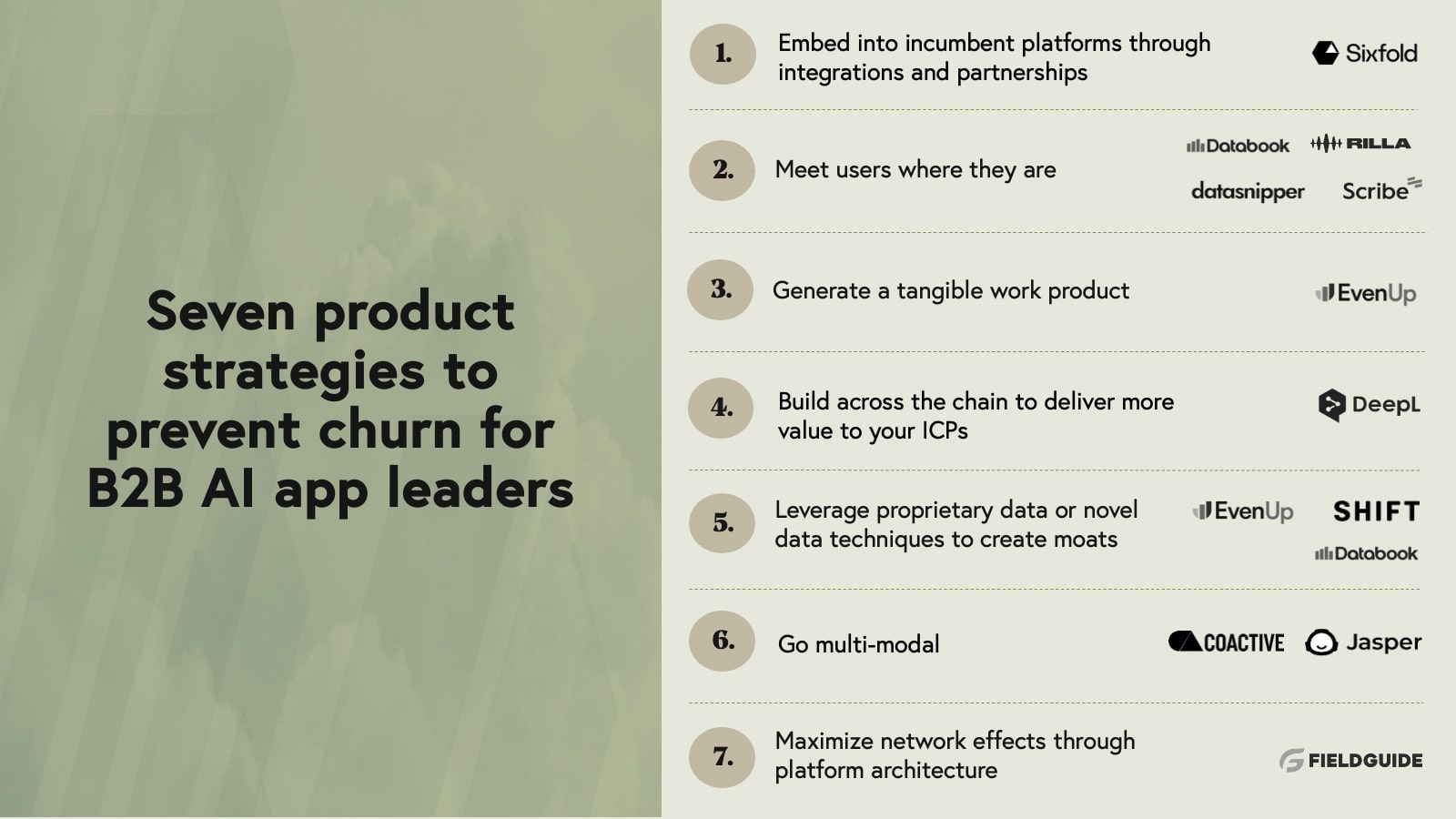
1. Embed into incumbent platforms through integrations and partnerships
B2B AI app startups have to start somewhere. It’s common to see companies go-to-market initially with a point solution, aiming to grow into a platform as the company matures. That said, as a point solution, it can sometimes be challenging to become deeply embedded into existing workflows. This poses a risk to user retention and engagement. However, we’ve seen B2B AI startups get resourceful here by partnering with other platforms, especially large incumbents, for leverage through tight integrations.
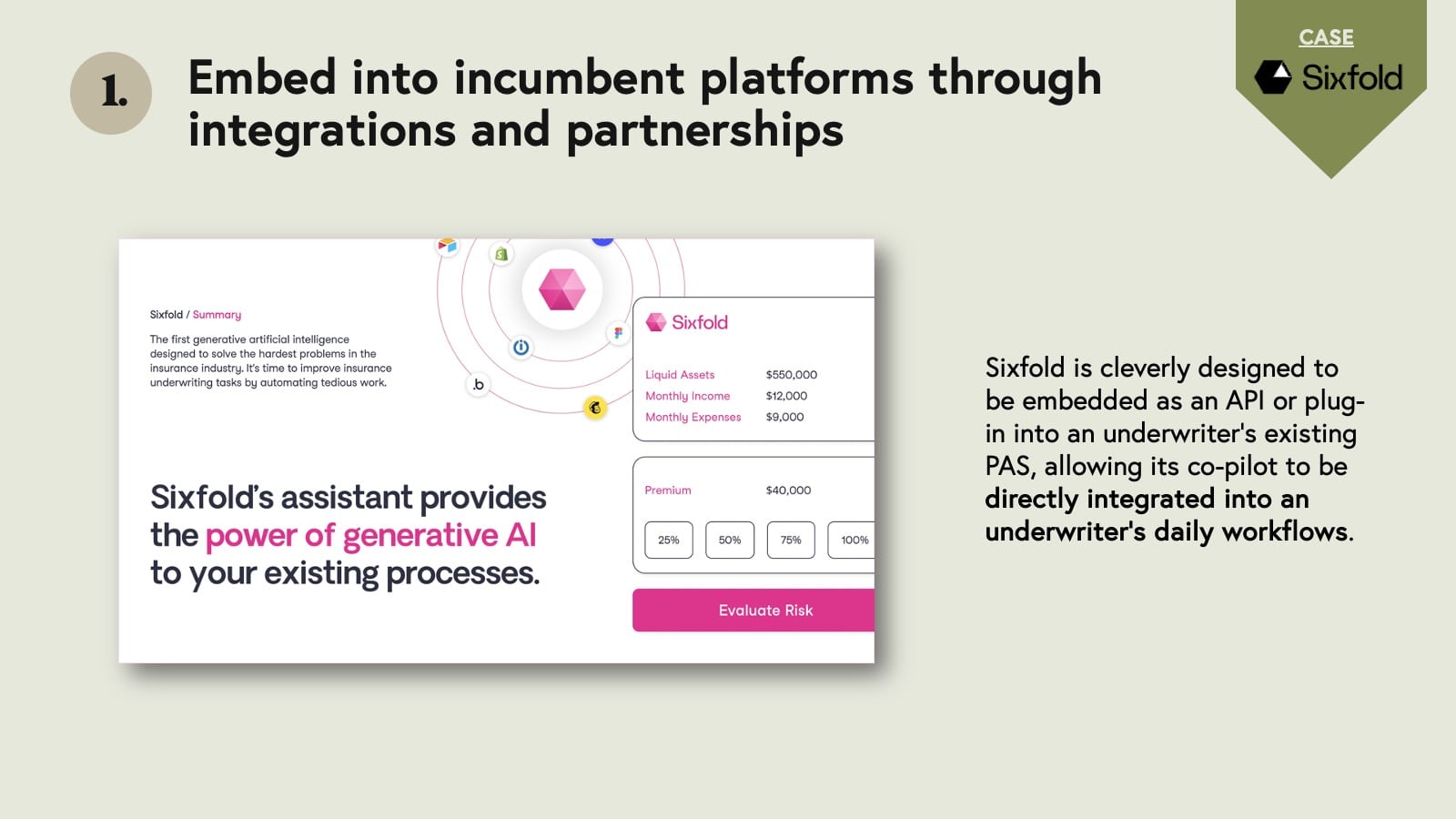
Bessemer portfolio company Sixfold – a leader in generative AI for insurance underwriters designed to boost underwriting capacity, accuracy, and transparency -- is a role model on this front. Underwriters typically work in Policy Administration Systems (PAS), which help them rate, quote, and bind insurance policies with insurance agents. Sixfold is cleverly designed to be embedded as an API or plug-in into an underwriter’s existing PAS, such that insurers do not need to overhaul legacy systems or replatform their workbench in order to interact with Sixfold’s co-pilot. Consequently, underwriters can experience the power of Sixfold’s AI very effortlessly since Sixfold is seamlessly integrated into existing daily workflows.
2. Meet users where they are
Related to embedding into workflows, B2B AI applications drive higher retention when their product meets users where they are. Unsurprisingly, usage and engagement metrics tend to drop off whenever users are faced with unnecessary friction to access a product (e.g., multiple sign-in portals, complicated click paths, or additional windows to open) as time-to-value becomes longer. To mitigate this, many B2B AI app companies make their products directly accessible within platforms that their customers use frequently as part of a daily workflow.
This could look different given your customer base and the technology you’re providing, but here are four exemplary case studies:
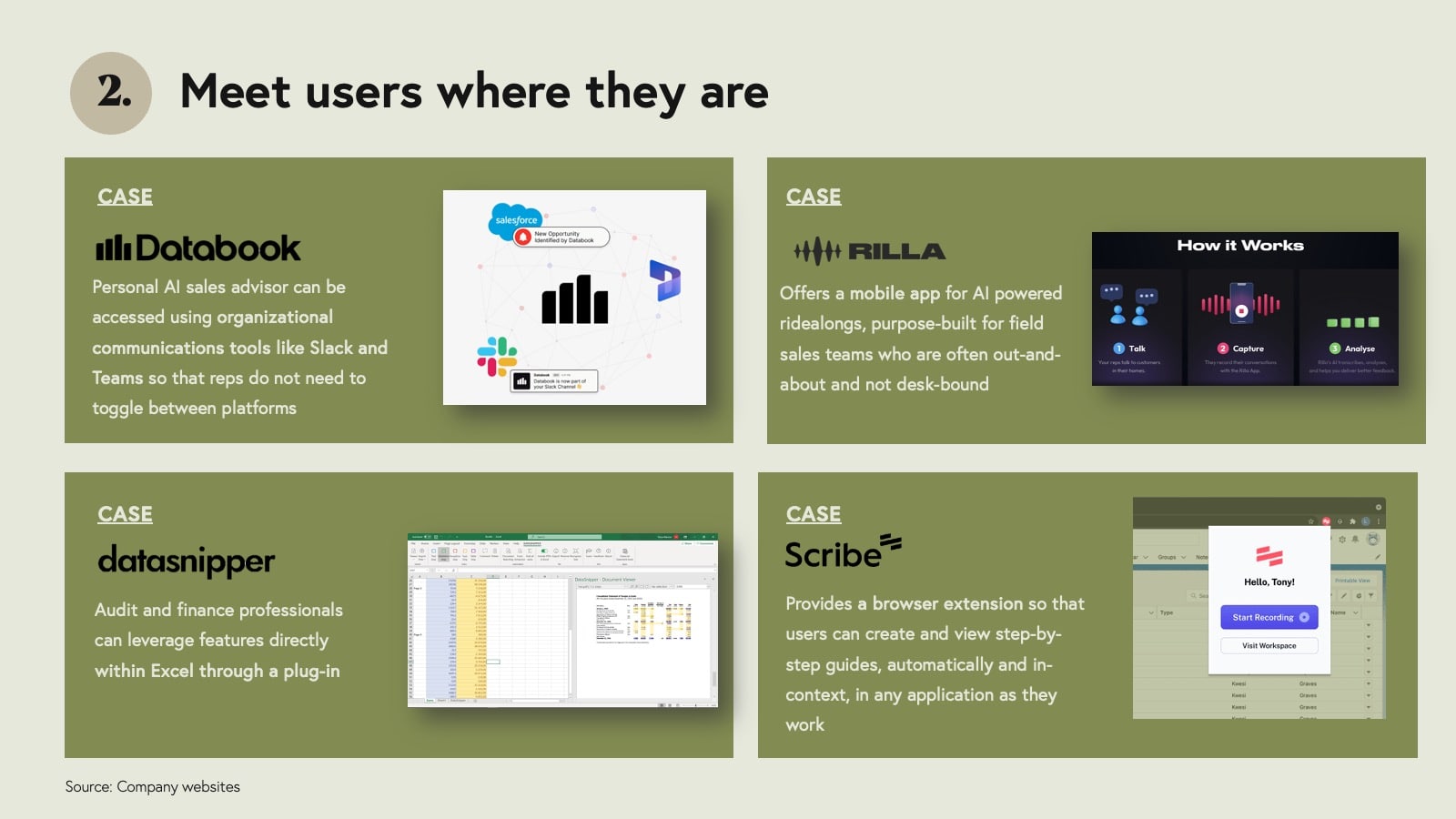
- Bessemer portfolio company Databook’s personal AI sales advisor can be accessed using organizational communications tools like Slack and Microsoft’s Copilot for Sales so that reps do not need to toggle between platforms.
- Rilla, a leader in virtual ridealongs for outside sales, offers a mobile app for AI powered ridealongs, purpose-built for field sales teams who are often out-and-about and not desk-bound.
- Datasnipper’s Intelligent Automation Platform can be accessed directly by audit and finance professionals within Excel through a plug-in.
- Scribe provides a browser extension so that users can automatically create and view step-by-step guides, in-context in any application as they work. Scribe's Sidekick lives on a user’s panel and directly surfaces Scribe content relevant to whatever page or application they are working on.
3. Generate a tangible work product offering
Enterprise workflows often involve the creation of a tangible work product. This could be a piece of analysis, document, or a report. One very effective way for B2B AI apps to lock in stickiness is to leverage AI to generate this outcome of a core work process.
Bessemer portfolio company EvenUp, which provides Demand Packages for Personal Injury Lawyers, exemplifies this strategy. Demand letters are a core yet time-intensive component of filing personal injury claims. EvenUp leverages AI, coupled with their proprietary database of settlement data, to automate the creation of demand letters. With this capability, EvenUp helps to free up precious time so lawyers can take on more cases and spend more time with their clients, instead of manually drafting letters. Additionally, because EvenUp’s one-of-a-kind database can locate relevant high-dollar-settlement precedents, its AI-generated letters contain unique value-add data points that help drive more revenue for attorneys.
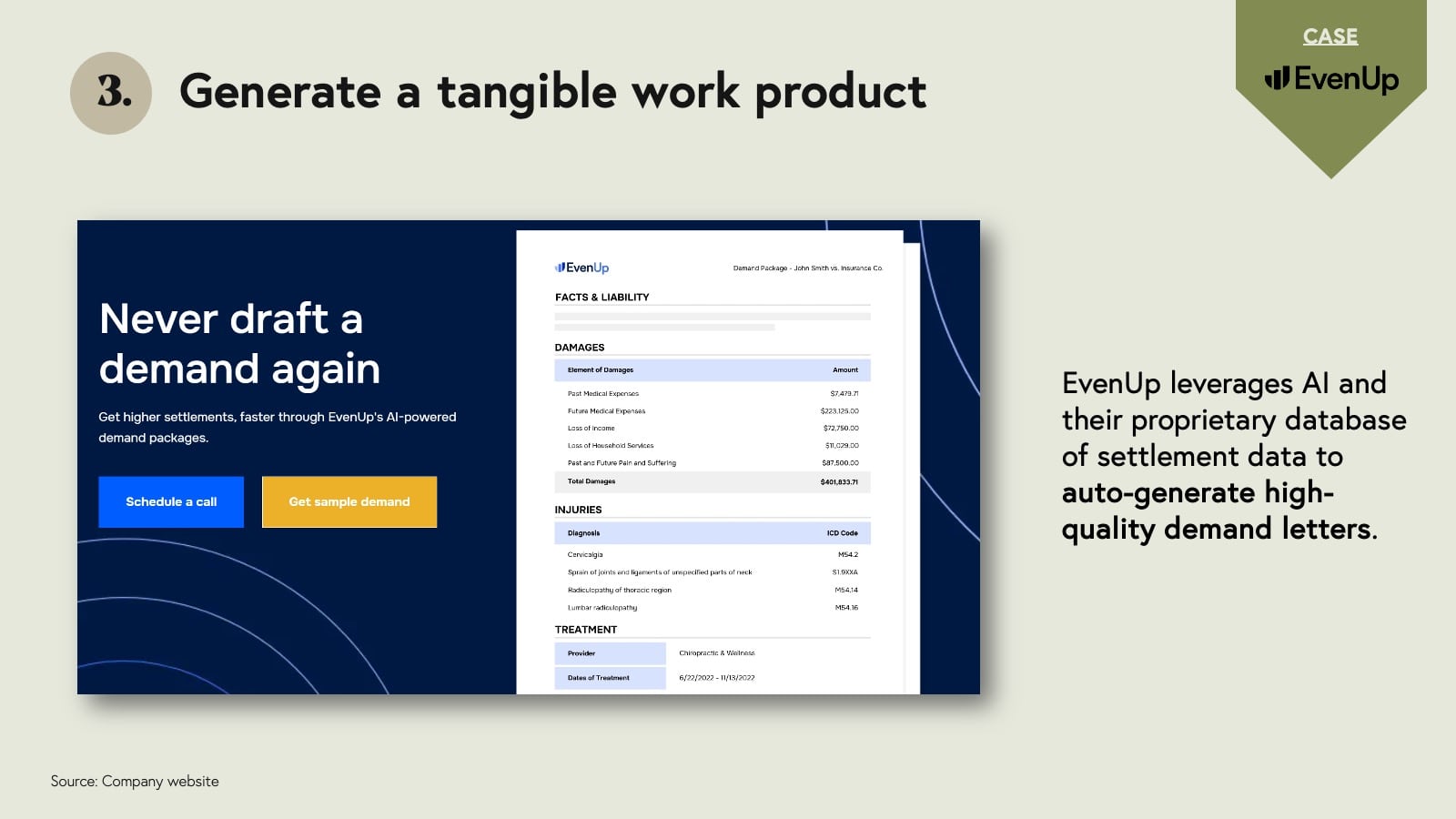
4. Build across the chain to deliver more value to your ICPs
After conquering a specific part of the workflow, we’ve seen B2B AI apps increase defensibility by moving across the value chain horizontally in order to deepen the relationship with users of an ideal customer profile (ICP).
Bessemer portfolio company DeepL, a full-stack neural machine translation service, exemplifies this principle. The company’s first offering involved large-transformer based NLP capabilities, yielding translation improvements across languages. Since then, DeepL has expanded its offering suite to adjacent capabilities beyond translation, including DeepL Write which was launched early last year as an AI-writing companion.
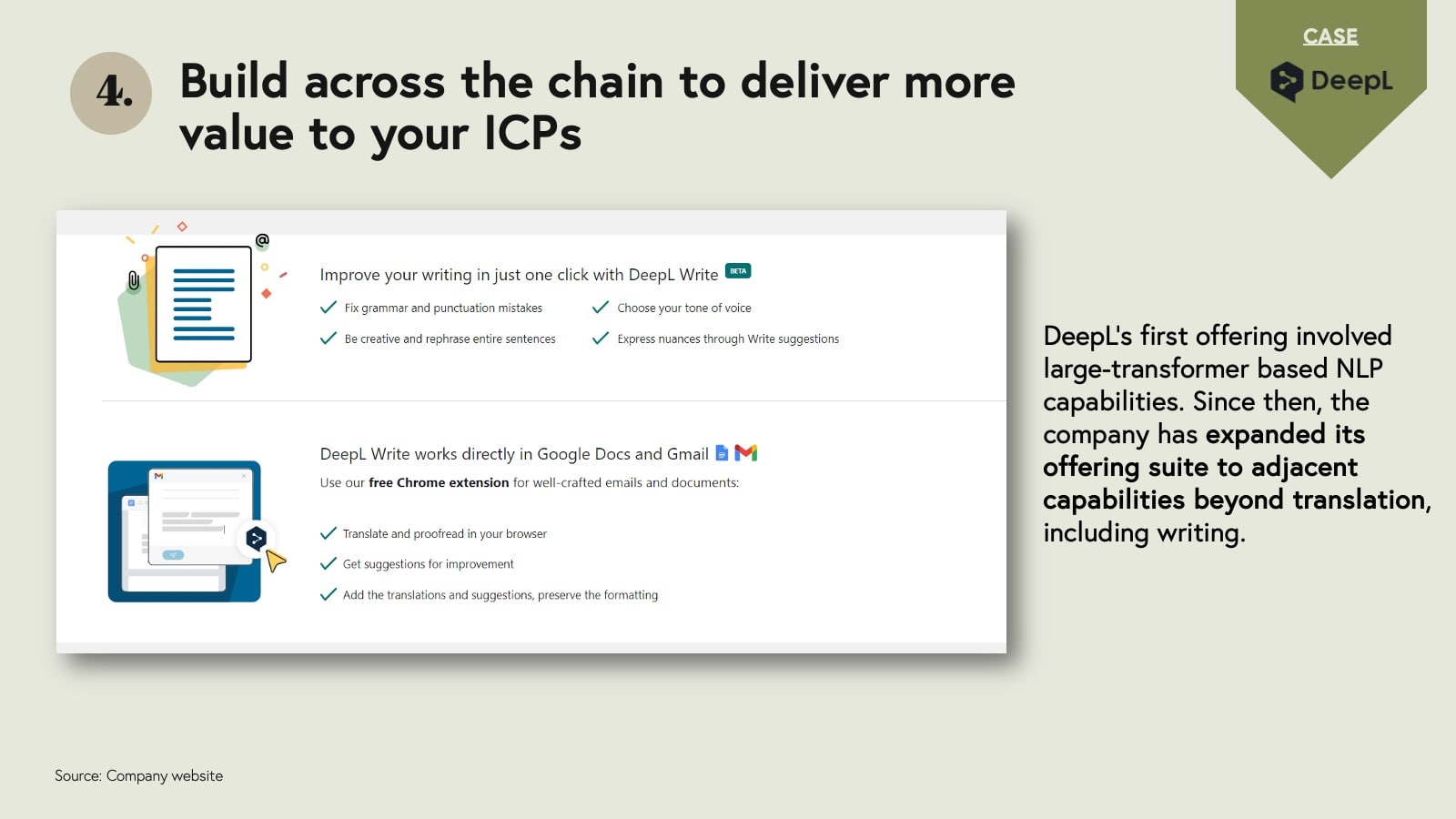
DeepL is a role model for how to evolve into a full-stack platform by building for a user’s broader value chain, ultimately increasing a business’ defensibility. Essentially what this means is that with each feature extension, a business reinforces value or extends product capabilities for its original ICPs.
5. Leverage proprietary data or novel data techniques to create moats
As B2B AI App leaders move across the stack, they don’t just reinforce ownership of the relationship with the end user, but can begin to shift upstream to reach a highly strategic part of the stack: the data layer.
This positioning can help to drive defensibility. For example, EvenUp has an intimate understanding of how different health systems and hospitals create their medical bills, so their AI can continuously get better at accurately parsing their billing information to feed their model to draft demand letters.
In another example, Databook augments public data (e.g., 10-Ks, annual reports, and earnings transcripts) and customer data (e.g., opportunities and use cases) with proprietary data including contact data, strategic priorities, and technographics. To enhance these data moats, they then apply proprietary computational analysis that feed into LLMs to deliver powerful account intelligence insights to customers.
Taking on the data layer drives defensibility.
Bessemer portfolio company Shift Technology is also a strong role model for how to leverage unique data techniques to build competitive advantage. Shift automates and optimizes critical insurance decisions with best-in-class AI powered by a novel unified data approach. Shift recognizes that on a first principles basis, better data can inform better decisions. Thus, their platform takes on the resource-intensive work of mapping insurer data, such as policy and claims data, with the best external data sources, such as government records and publicly available social media, resulting in a single, powerful unified data set for risk detection and claims automation.
6. Go multi-modal
Today, enterprises face a proliferation of data sources and formats, so as B2B AI App leaders think about product expansion, having a multi-modal offering is often another effective way to extend platform capabilities into adjacent areas.
A great case study here is from Bessemer portfolio company Jasper. A primary early use case for marketers adopting Jasper's AI solution was the creation of long-form blog posts using text-based GenAI capabilities. Naturally, once the post was generated by AI and edited by a marketer, the next logical step in the workflow was to find appropriate imagery to bring the blog post to life. So Jasper recently completed the acquisition of Clickdrop to strengthen its Jasper Art product, using multi-modal capabilities (both text and image) to address a marketer’s entire value chain.
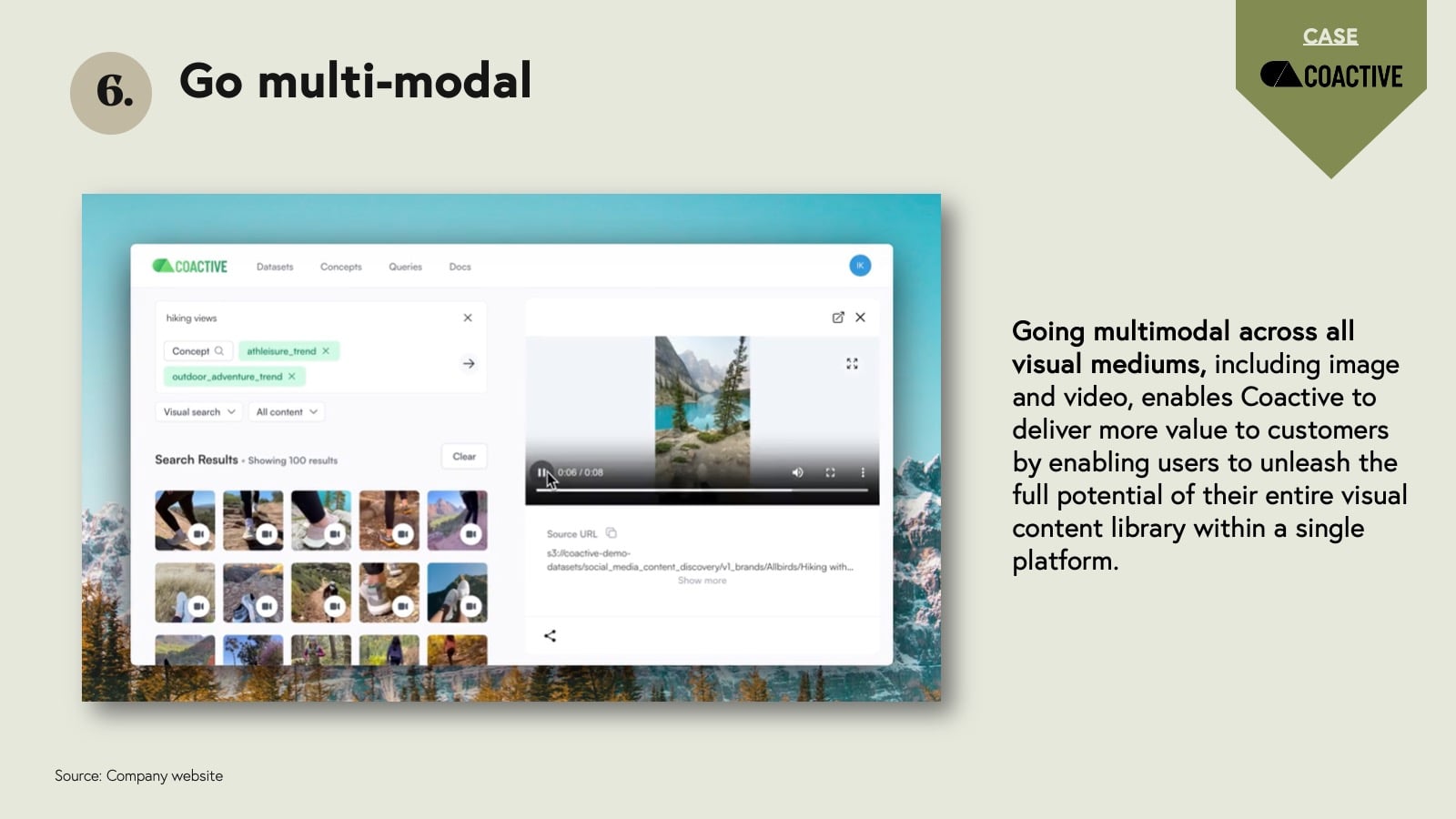
Another role model here is Bessemer portfolio company Coactive.ai that helps enterprises to derive key business insights from all types of visual content, including video and images, using a data-centric approach. Visual data has traditionally been an under-tapped resource at companies since incumbent tooling is often limited in capabilities to handle unstructured data. Going multimodal across all visual mediums enables Coactive to deliver more value to customers by enabling users to unleash the full potential of these content sources within a single platform. For instance, customers can run AI-powered search or create concepts across their entire visual content library from Coactive’s platform in order to gain a holistic view across different use cases.
7. Maximize network effects through platform architecture
Among developer SaaS platforms and PLG leaders, we’ve seen how creating a flywheel of network effects is a powerful way to drive stickiness — whether it’s in a pricing strategy, go-to-market approach, or features within the product. This perennial principle on the power of network effects holds true for emergent B2B AI apps as well. Bessemer portfolio company, Fieldguide, (AI built for advisory and audit) illustrates how to execute on this tenet, as its platform architecture is strategically built with both practitioner and client-facing interfaces in order to drive and maximize network effects.
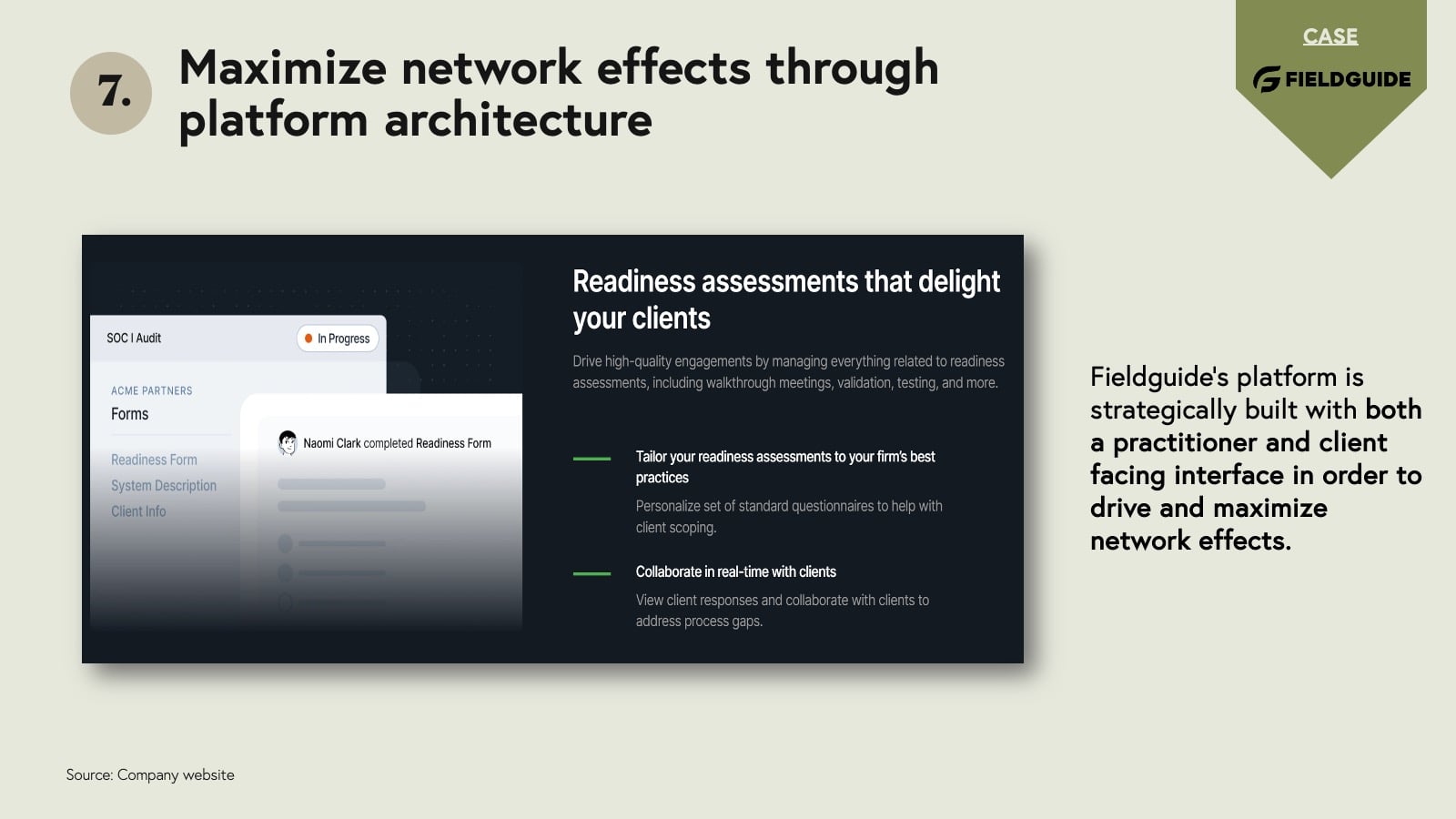
Fieldguide simplifies engagement management by replacing a multitude of point solutions with one end-to-end, AI-powered platform. This provides practitioners with all of the functionality needed across the engagement lifecycle in one place - from testing and controls to client requests, report writing, and analytics. Most importantly, integrated collaboration tools enable teams to coordinate and share documents easily, fostering networks within organizations.
Moreover, practitioners can invite their end-user clients, such as CEOs, CFOs, risk and compliance leaders, CISOs, and Internal Audit leaders, to access the Fieldguide platform through a secure, role-based client portal. This allows clients to respond to evidence requests, collaborate on documents, and stay updated on engagement progress in a streamlined and intuitive manner. Clients can conveniently view assigned information like requests, tasks, and comments without searching through emails or making manual edits. Bringing clients onto the platform enhances distribution virality.
Fieldguide exemplifies the power of a product that enables both sides of the market to actively engage with a single platform. This dual engagement fuels sharing, boosts engagement levels, drives adoption rates, and ultimately amplifies the value for all participants within the network as time progresses.
User-centricity is key for app layer companies
These case studies illustrate how product strategy can play a critical role in mitigating churn for B2B AI applications. A unifying theme amongst all these examples is that B2B AI app companies must build products with a deep level of user empathy and awareness, as every industry or role has specific workflows and nuances.
Ultimately, application layer companies are in such a unique position given that they sit closest to the end user. So we implore all B2B AI app companies to capitalize on this unique position and take full ownership of the user relationship to build out highly-beloved AI products!
If you’re a Horizontal or Vertical AI B2B application, we’re curious to learn how you’re building defensibility through product strategy. Email us at Janelle Teng (jteng@bvp.com) and Sameer Dholakia (sdholakia@bvp.com) to discuss.






